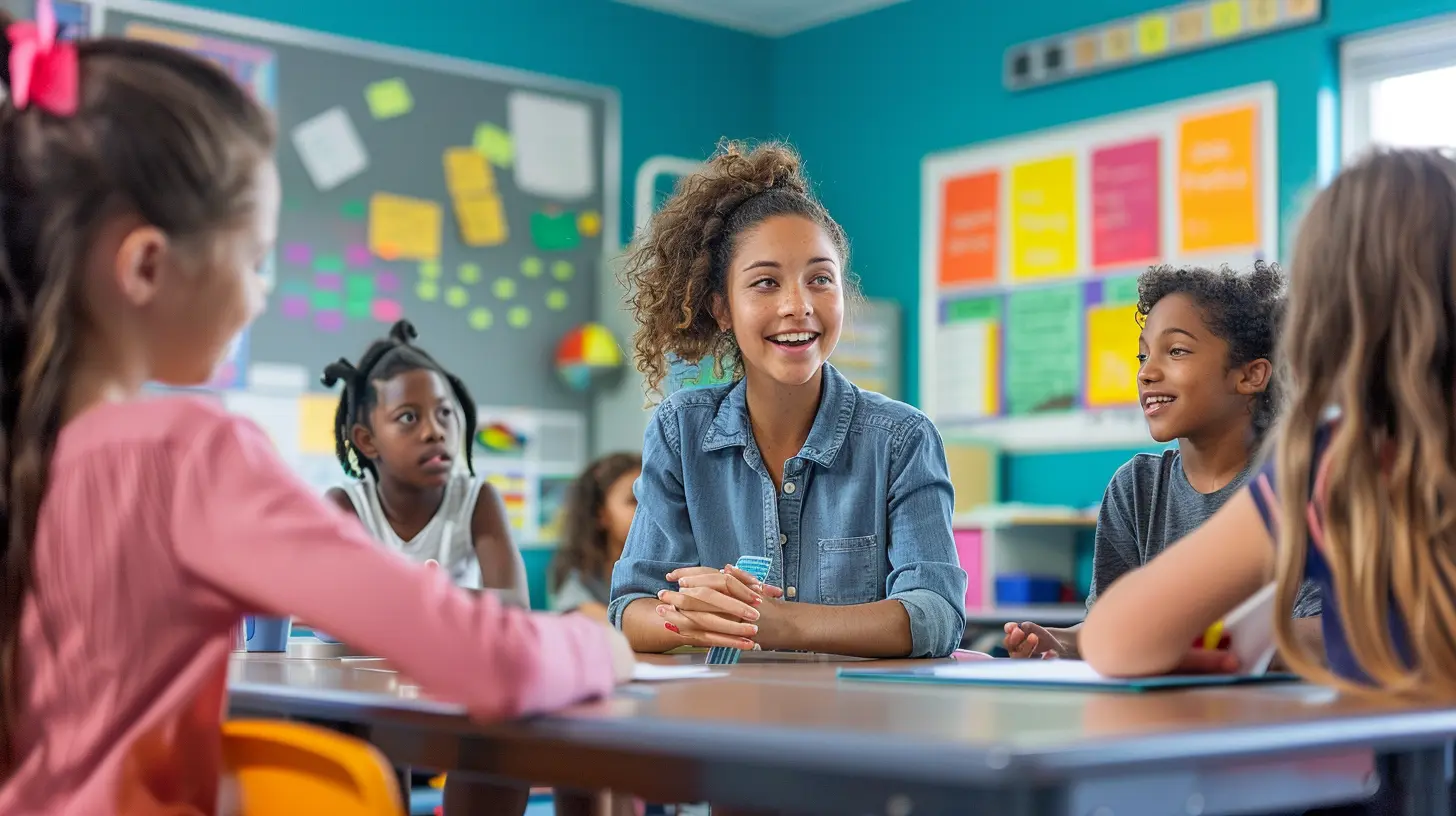How to Foster a Team-Oriented Classroom with Collaborative Learning
18 November 2025
We’ve all heard it before—"two heads are better than one." But when it comes to the classroom, it’s not just about doubling brainpower. It’s about creating a space where students work together, grow together, and actually enjoy learning.
Now, does that mean group work all day, every day? Not quite.
A team-oriented classroom is built on trust, shared goals, and a bit of magic: collaborative learning. It’s not just a teaching strategy; it’s a mindset. So, grab your coffee (or tea!) and let’s dive into how to turn your classroom into a thriving, team-fueled learning hub.
What Is a Team-Oriented Classroom, Anyway?
Imagine a classroom buzzing with meaningful chatter. Students building on each other's ideas. Laughter mixed with problem-solving. That’s the vibe of a team-oriented classroom.In short, it’s a learning environment where students see themselves not as solo competitors, but as supportive team members. Everyone plays a role. Everyone brings something to the table.
It doesn’t mean competition gets tossed out the window. Instead, the win is shared—and it's learning itself.
Why Collaborative Learning Matters
Here’s the thing: we don’t live in bubbles. Whether it’s in school, work, or life, collaboration is key. In a classroom setting, when students learn together, they develop critical soft skills like communication, empathy, and conflict resolution.But wait, there’s more!
Collaborative learning taps into multiple learning styles. It amps up engagement, boosts retention, and even helps the shy kiddos speak up. It’s learning that sticks because it feels real and meaningful.
The Core Principles of a Team-Oriented Classroom
Before we throw students into group assignments, let’s understand the building blocks. You can’t build a skyscraper on a shaky foundation, right?1. Shared Responsibility
Everyone contributes. No freeloaders allowed—but also, let’s not shame those still learning how to participate. Shared responsibility means creating structures that allow each student to add value in their own way.2. Mutual Respect
Every voice counts, even the quiet ones. It’s about listening as much as talking. You set the tone here, and trust me, students follow your lead.3. Interdependence
This is the glue of teamwork. Students understand they need each other to succeed. It’s not about doing everything together but doing the right things, together.4. Accountability
It’s not group work if one student does it all. Build systems where teams check in with each other, set goals, and reflect on progress. That’s real ownership.
Setting the Stage: Creating the Right Environment
Let’s be honest: collaboration doesn't happen by accident. You’ve got to cultivate it like a garden. Here’s how to prep your classroom soil:a) Classroom Layout Matters
Ever notice how furniture affects the mood? Desks in rows say “work alone.” Clusters and circles say “let’s talk.” A flexible arrangement screams, “We’re in this together.”Move things around. Let the physical space reflect your values.
b) Establish Norms (Together!)
Don’t just tell students how to behave—build community norms with them! Ask questions like:- “What does a respectful team look like?”
- “How do we handle disagreements?”
- “What should we do if someone’s not pulling their weight?”
When students help set the rules, they’re more likely to respect them.
c) Use Team-Building Activities Early & Often
Don't wait until mid-semester. Start bonding from day one with activities that aren’t intimidating. Think quick icebreakers, problem-solving games, or even a silly trivia challenge.It’s like stretching before a workout—essential for keeping things smooth later on.
Strategies to Spark Collaborative Learning
Here’s where the fun begins. How can you actively encourage collaboration without causing chaos or relying on outdated group projects?Let’s explore some tried-and-true methods that work in real classrooms.
1. Think-Pair-Share
This one’s a classic—and for good reason. Students first think about a prompt independently, then pair up to discuss, and finally share with the larger group. It's structured, simple, and can be squeezed into any lesson.Why it works? It gives introverts space to process and extroverts a chance to express themselves.
2. Jigsaw Method
Split a topic into chunks and assign each student or group a "piece" of the puzzle. They become the expert in their slice, then teach it to others.Not only does it build accountability, but it also turns students into teachers (which, let’s face it, is one of the best ways to learn).
3. Project-Based Learning (PBL)
Think of this as collaboration on steroids. PBL revolves around real-world challenges that take time, planning, and teamwork to solve.Whether it’s designing a sustainable city or creating a podcast, projects force students to lean on each other and combine skills.
4. Peer Feedback Practices
Here’s a gem that’s often overlooked. Let students review each other’s work!Start small: “What’s one thing you liked and one thing that could improve?” Over time, students learn how to give and receive helpful feedback—another life skill in disguise.
5. Digital Collaboration Tools
Welcome to the 21st century! Platforms like Google Workspace, Padlet, Jamboard, and Trello are goldmines for team activities.They allow for real-time editing, brainstorming, and planning—even when students aren’t in the same room.
Dealing with Group Work Headaches
Let’s not sugarcoat it: group work can be messy. Someone takes over. Someone zones out. Someone forgets to turn in their part.So how do we fix it?
a) Design Roles
Assign clear, rotating roles like:- Facilitator (keeps the group on task)
- Recorder (writes things down)
- Timekeeper (makes sure they stay on schedule)
- Reporter (shares out to the class)
It structures participation and prevents dominance.
b) Scaffold Collaboration
Too much freedom too fast can sink a ship. Start with highly structured tasks and slowly loosen the reins as students get more confident.Think of it like training wheels. Once they’ve got balance, they’ll take off.
c) Monitor & Mediate
Be a fly on the wall, but step in when needed. Sometimes just your presence is enough to keep things moving in the right direction. Ask questions, provide coaching, and nudge teams toward better dynamics.Building Trust Among Students
Here’s a truth bomb: students won’t collaborate well if they don’t trust each other.Building trust isn’t instant. It’s slow-cooked. But here are a few ways to speed it up:
- Celebrate successes publicly, even small wins.
- Allow vulnerability—like sharing mistakes or personal stories.
- Foster a “no-blame” zone. Focus on solutions, not shame.
Trust turns collaboration from a task into a habit.
Assessment: Yes, You Can Grade Collaborative Learning
“But how do I grade it?” That’s the #1 question teachers ask about group work.Fair concern. A few tips:
- Mix individual and group assessments.
- Use rubrics that include collaboration skills (communication, cooperation, etc.).
- Include self and peer evaluations.
- Reflect often—have students write about what they did, learned, and contributed.
Grading collaboration is less about scores and more about growth.
Encouraging Reflection and Growth
Reflection ties it all together. After group tasks, ask questions like:- “How did your team work together?”
- “What role did you play?”
- “What would you do differently next time?”
Reflection turns experience into learning. It’s the secret sauce of progress.
The Role of the Teacher: From Instructor to Coach
In a team-oriented classroom, you're not the “sage on the stage”—you’re the guide on the side.Your job? Set the tone, model collaboration, and support students as they figure it out. Sometimes you lead, sometimes you listen. Sometimes you're the cheerleader, sometimes the referee.
And that’s the beauty of it.
Real Talk: What If It Doesn’t Work?
Hey, we’ve all been there—group work flops. Students get frustrated. You get frustrated. It’s tempting to say, “This just isn’t for my class.”But here’s the thing: collaboration is a skill. And like any skill, it takes practice. Keep at it. Tweak your approach. Be transparent with students. Let them in on the process.
You’re not just teaching curriculum—you’re teaching how to be a good teammate. That’s a life lesson they don’t forget.
Final Thoughts
Fostering a team-oriented classroom with collaborative learning isn’t about perfection. It’s about making your class a space where students lean on each other, lift each other, and learn from each other.You’re building more than academic knowledge—you’re shaping future coworkers, leaders, and citizens.
So next time your students huddle around a whiteboard, trying to crack a tough problem together, smile. You’re not just running a classroom. You’re captaining a dream team.
all images in this post were generated using AI tools
Category:
Collaborative LearningAuthor:

Bethany Hudson

